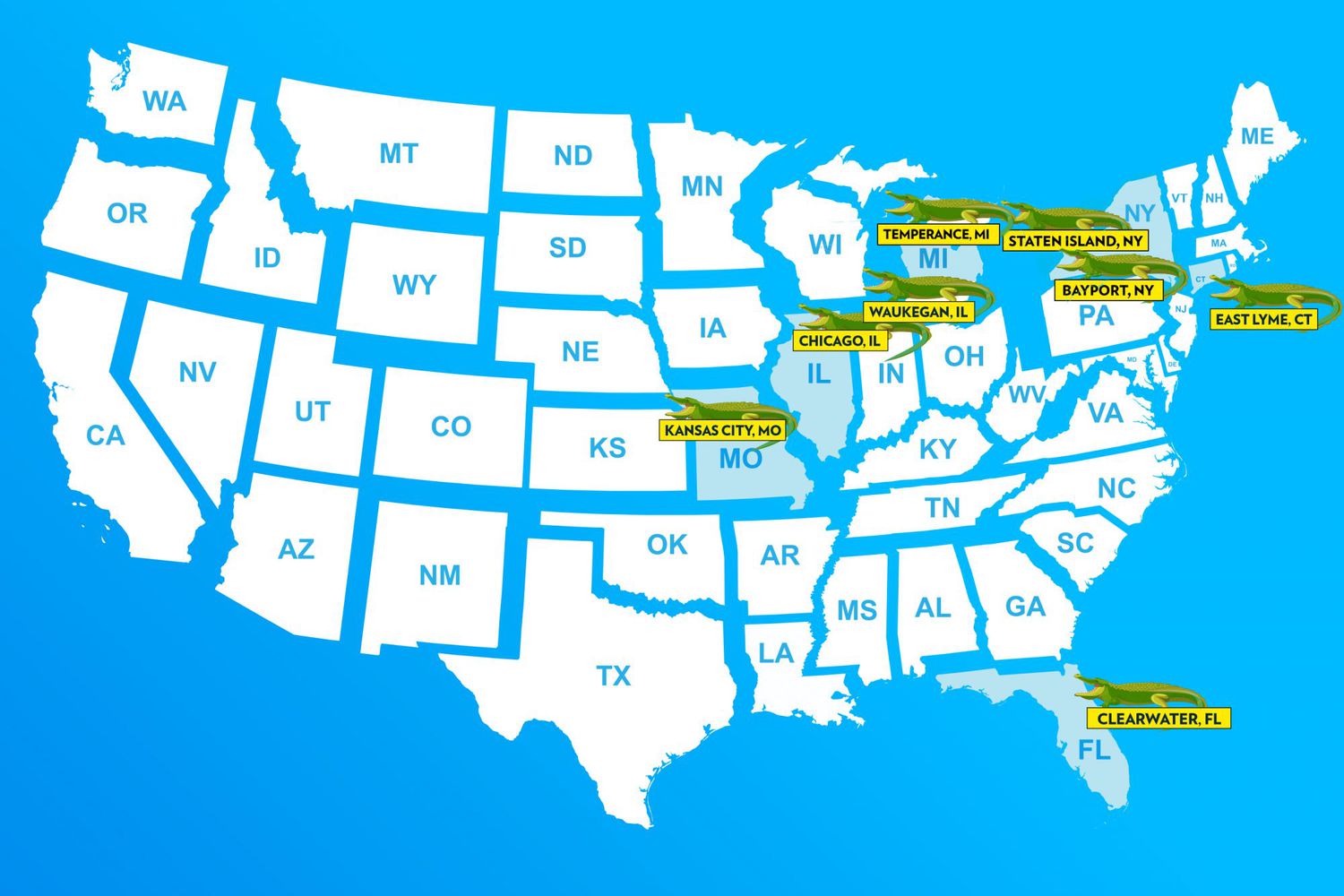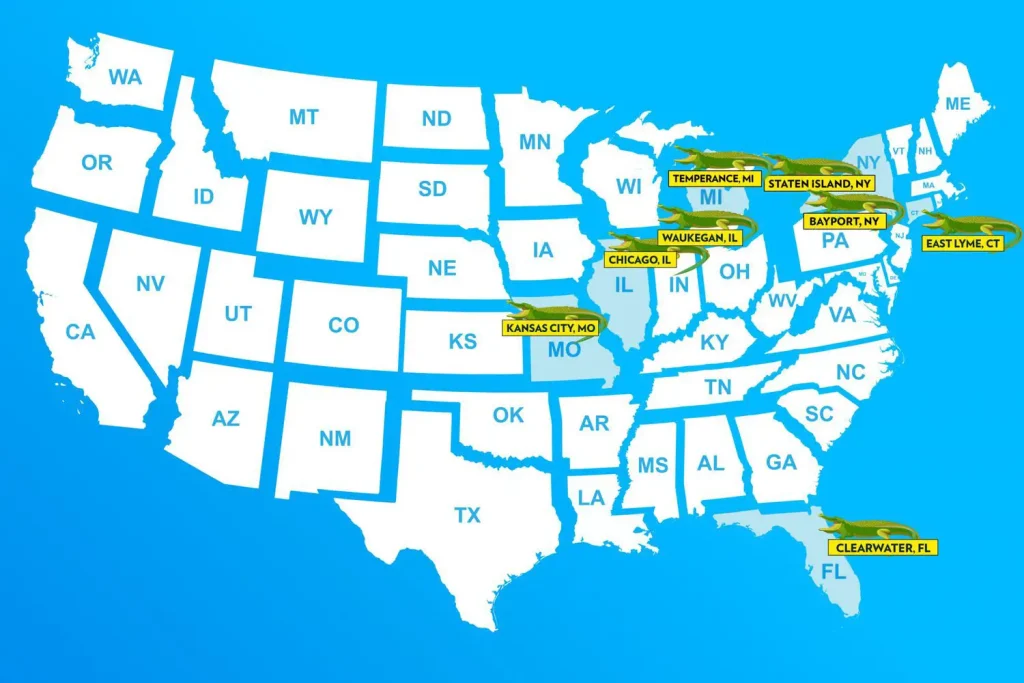Alligators are fascinating creatures that have captured the imagination of people around the world. These reptiles have been around for millions of years and are known for their fierce jaws, impressive size, and unique appearance.
If you’re wondering which states have alligators, you’ll be pleased to know that they are found in many regions of the United States. From the swamplands of Florida to the bayous of Louisiana, alligators are a common sight in many southern states. So, let’s dive in and explore where you can find these magnificent creatures in the USA.
Alligators can be found in several states across the southeastern United States, including Florida, Louisiana, Georgia, Alabama, Mississippi, South Carolina, and Texas. These states provide the necessary habitats for alligators, including swamps, marshes, lakes, and rivers. It is important to note that in some states, such as Florida, alligators are more common and may pose a greater risk to humans. If you are in an area with alligators, be sure to follow safety guidelines and keep a safe distance from these powerful creatures.

Alligators in the United States: What You Need to Know
Alligators are one of the most recognizable reptiles in the world, known for their large size, powerful jaws and distinctive appearance. These formidable creatures are found throughout the southeastern United States, but some states have more alligators than others. In this article, we’ll explore which states have alligators and why these reptiles are so important to the ecosystem.
Florida: The Alligator Capital of the World
Florida is home to the largest population of alligators in the world, with an estimated 1.3 million alligators living throughout the state. These reptiles can be found in almost every body of fresh water in Florida, from swamps and marshes to lakes and ponds. Alligators are so common in Florida that it’s not unusual to see them sunning themselves on golf courses or in residential areas.
Florida’s alligator population has been carefully managed for decades to ensure that these reptiles don’t become a threat to humans. Alligator hunting is strictly regulated, and alligator farmers are required to follow strict guidelines to ensure that their animals are well-cared for and not mistreated.
Louisiana: The Alligator State
Louisiana is another state with a large alligator population, with an estimated 2 million alligators living throughout the state. These reptiles can be found in almost every marsh, swamp and bayou in Louisiana, and they play an important role in the state’s ecosystem. Alligators help to control the population of smaller animals, and they help to keep the waterways clean by eating dead fish and other debris.
Louisiana has a thriving alligator hunting industry, with hunters from all over the world coming to the state to hunt these reptiles. Alligator meat is also a popular delicacy in Louisiana, and many restaurants serve dishes made with alligator meat.
Texas: Home to Alligator Gar
Texas is home to a unique species of alligator known as the alligator gar. These fish are found in rivers and lakes throughout Texas, and they can grow up to 10 feet in length and weigh up to 300 pounds. Alligator gar are an important part of the state’s ecosystem, and they help to keep the waterways clean by eating dead fish and other debris.
Alligator gar fishing is a popular pastime in Texas, and many anglers come to the state to try their luck at catching these massive fish. Alligator gar meat is also considered a delicacy in some parts of the state.
South Carolina: Alligators in the Lowcountry
South Carolina is home to a significant alligator population, particularly in the Lowcountry region of the state. These reptiles can be found in swamps, marshes and rivers throughout the state, and they play an important role in the ecosystem by keeping the population of smaller animals in check.
Alligator hunting is legal in South Carolina, but it’s tightly regulated to ensure that these reptiles don’t become over-hunted. Many South Carolina residents also enjoy watching alligators in their natural habitat, and there are several wildlife refuges in the state where visitors can observe these creatures up close.
Georgia: Alligators in the Okefenokee Swamp
Georgia is home to a large alligator population, particularly in the Okefenokee Swamp in the southern part of the state. These reptiles can be found in almost every body of water in the state, from rivers and lakes to swamps and marshes.
Alligator hunting is legal in Georgia, but it’s tightly regulated to ensure that these reptiles don’t become over-hunted. Many Georgia residents also enjoy watching alligators in their natural habitat, and there are several wildlife refuges in the state where visitors can observe these creatures up close.
Mississippi: Alligators in the Delta
Mississippi is home to a significant alligator population, particularly in the Delta region of the state. These reptiles can be found in rivers, lakes, swamps and marshes throughout Mississippi, and they play an important role in the state’s ecosystem.
Alligator hunting is legal in Mississippi, but it’s tightly regulated to ensure that these reptiles don’t become over-hunted. Many Mississippi residents also enjoy watching alligators in their natural habitat, and there are several wildlife refuges in the state where visitors can observe these creatures up close.
North Carolina: Alligators in the Coastal Plain
North Carolina is home to a small but growing alligator population, particularly in the Coastal Plain region of the state. These reptiles can be found in swamps, marshes and rivers throughout North Carolina, and they play an important role in the state’s ecosystem.
Alligator hunting is not legal in North Carolina, but many residents enjoy watching alligators in their natural habitat. There are several wildlife refuges in the state where visitors can observe these creatures up close.
Alabama: Alligators in the Mobile-Tensaw Delta
Alabama is home to a small but growing alligator population, particularly in the Mobile-Tensaw Delta region of the state. These reptiles can be found in rivers, lakes, swamps and marshes throughout Alabama, and they play an important role in the state’s ecosystem.
Alligator hunting is legal in Alabama, but it’s tightly regulated to ensure that these reptiles don’t become over-hunted. Many Alabama residents also enjoy watching alligators in their natural habitat, and there are several wildlife refuges in the state where visitors can observe these creatures up close.
Arkansas: Alligators in the Delta
Arkansas is home to a small but growing alligator population, particularly in the Delta region of the state. These reptiles can be found in rivers, lakes, swamps and marshes throughout Arkansas, and they play an important role in the state’s ecosystem.
Alligator hunting is legal in Arkansas, but it’s tightly regulated to ensure that these reptiles don’t become over-hunted. Many Arkansas residents also enjoy watching alligators in their natural habitat, and there are several wildlife refuges in the state where visitors can observe these creatures up close.
Virginia: Alligators in Coastal Areas
Virginia is home to a small but growing alligator population, particularly in the coastal areas of the state. These reptiles can be found in swamps, marshes and rivers throughout Virginia, and they play an important role in the state’s ecosystem.
Alligator hunting is not legal in Virginia, but many residents enjoy watching alligators in their natural habitat. There are several wildlife refuges in the state where visitors can observe these creatures up close.
In conclusion, alligators are an important part of the ecosystem in the southeastern United States. While some states have more alligators than others, these reptiles play a vital role in controlling the population of smaller animals and keeping the waterways clean. Whether you’re a hunter, angler, or wildlife enthusiast, there are plenty of opportunities to observe and appreciate these magnificent creatures in their natural habitat.
Frequently Asked Questions
Which states in the US have alligators?
Alligators are primarily found in the southeastern part of the United States. This includes Florida, Louisiana, Georgia, Alabama, Mississippi, South Carolina, and Texas. Alligators are most commonly found in Florida, which has the largest population of alligators in the US.
Other states may have small populations of alligators, but they are not as common and are mostly found in zoos or wildlife parks. It’s important to remember that alligators are dangerous animals and should be treated with caution and respect at all times.
Are there alligators in California?
No, there are no wild alligators in California. Alligators are primarily found in the southeastern part of the United States. However, there may be some alligators in California in zoos or other wildlife parks. It’s important to remember that alligators are dangerous animals and should be treated with caution and respect at all times.
If you’re interested in seeing alligators in their natural habitat, you’ll have to travel to one of the southeastern states where they are more commonly found.
Can alligators live in cold weather states?
Alligators are cold-blooded animals, which means that their body temperature is regulated by the environment around them. While alligators can survive in colder temperatures for short periods of time, they are primarily found in warmer climates.
Alligators can be found in parts of Texas and Louisiana, which can experience colder temperatures during the winter months. However, it’s important to remember that alligators are primarily found in the southeastern part of the United States, where the climate is warmer and more conducive to their survival.
What is the largest alligator ever recorded in the US?
The largest alligator ever recorded in the United States was 19 feet and 2 inches long. It was found in Louisiana in 1890 and weighed over 2,000 pounds. This alligator is known as the “The Louisiana Alligator,” and it is still considered to be the largest alligator ever recorded in the US.
While alligators can grow to be quite large, it’s important to remember that they are dangerous animals and should be treated with caution and respect at all times.
Can you hunt alligators in the US?
Yes, you can hunt alligators in the United States, but there are strict regulations in place to ensure that the population of alligators is not threatened. Hunting alligators is only allowed during specific times of the year, and hunters must have a permit and follow all rules and regulations set forth by the state in which they are hunting.
It’s important to remember that alligators are dangerous animals and should be treated with caution and respect at all times, whether you’re hunting them or simply observing them in their natural habitat.
USA States That Have Alligators
In conclusion, alligators are one of the most fascinating creatures in the animal kingdom. They are found in a number of states across the United States, including Florida, Louisiana, Georgia, and Texas, among others. These states provide a natural habitat for these amazing creatures, and many people travel from all over the world to witness them in their natural habitat.
If you’re a fan of alligators and want to see them up close, there are several places you can visit. Many national parks and wildlife sanctuaries offer tours and educational programs that allow you to learn more about these incredible animals and see them in their natural habitat.
Overall, alligators are an important part of the ecosystem in many states across the country. They are powerful, fascinating creatures that have captivated people’s attention for centuries. Whether you’re an animal lover or simply fascinated by these prehistoric beasts, there’s no denying that alligators are a truly amazing species.

